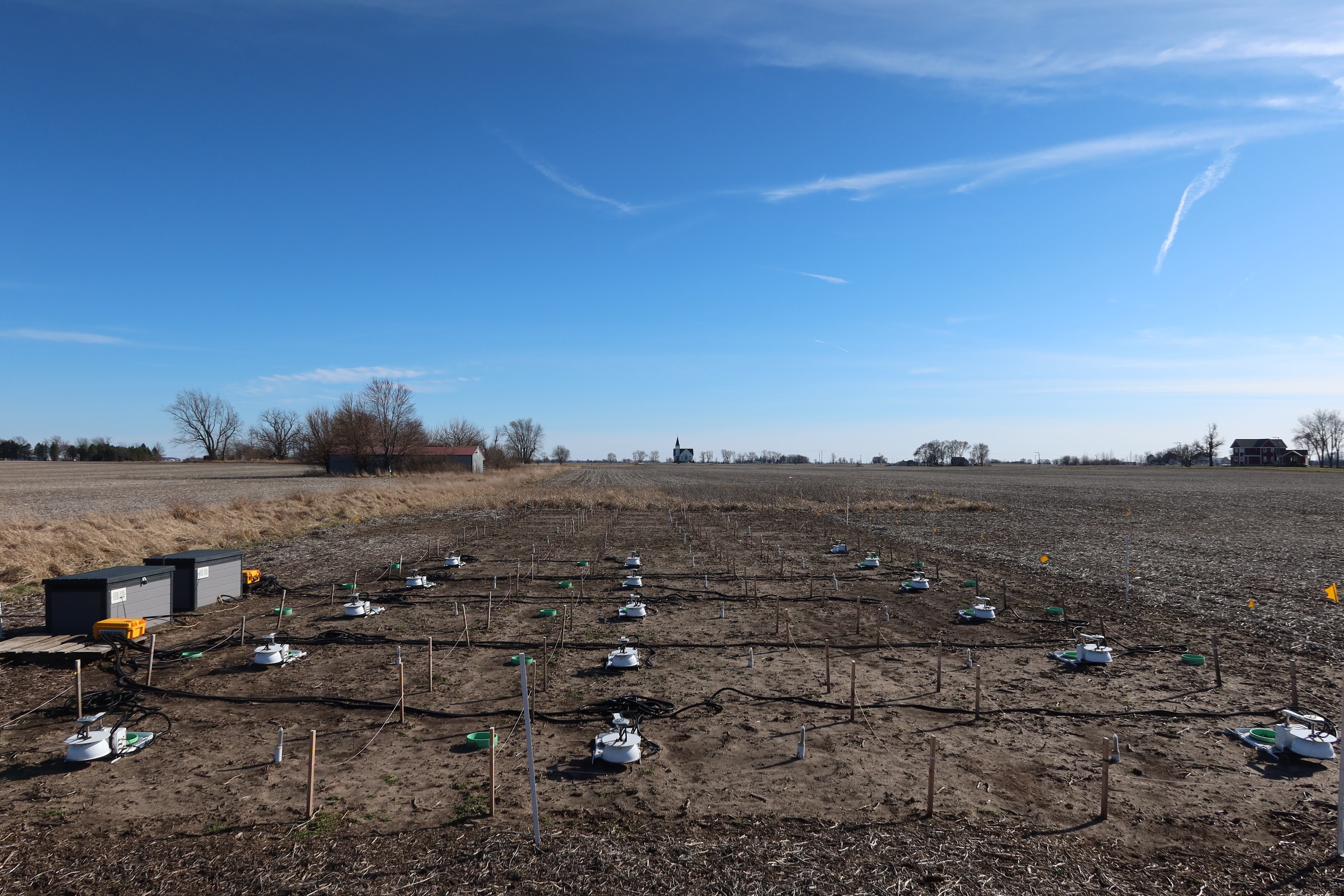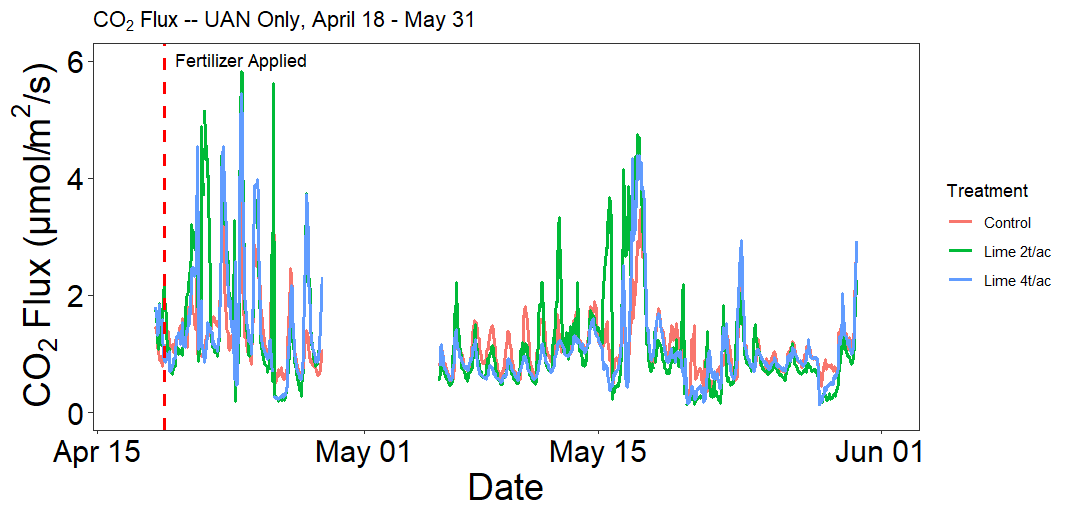.jpg)
In November 2023, we teamed up with Erich Schott, a multi-generational farmer from Kankakee County, Illinois, and Professor Andrew Jacobson, an aqueous geochemist at Northwestern University, to assess the effectiveness of enhanced weathering (EW) of carbonate minerals on Midwestern soils. The Midwest alone has over 100 million acres of agricultural land, making it an ideal location to develop EW. To scale responsibly, however, we must first understand how to reliably measure and optimize EW across the region’s various soil types and farming practices. Early, and promising, results from this work are outlined in this blog post.
Almost all EW research to date has focused on silicate rocks (e.g., basalt) and minerals (e.g., olivine). Carbonate minerals, however, weather at least 100,000 times faster than silicate minerals (Palandri and Kharaka 2004), and are more likely to offer carbon dioxide removal (CDR) at timescales relevant to the climate crisis (Shi et al., 2025). Limestone is an abundant carbonate rock that is already applied safely to farmland to amend soil pH in many regions across the world, including the Midwest. Its CDR potential, when applied under the correct conditions, has largely been overlooked… until recently (Hamilton et al., 2007, Knapp and Tipper 2022, McDermott et al., 2024, Shi et al., 2025).
Over the last two years, we established several highly instrumented field trials to investigate EW outcomes in a range of conditions. We focused this work primarily on carbonate, but also on reactive silicate minerals, and are currently monitoring over 100 research plots split across two soil types in the Midwest. Our team is testing the effects of amendment type, application rate, fertilizer addition, and crop type on the production and export of bicarbonate (HCO3-)—the carbon storage molecule. Our goal is to build a clear, data-based understanding of EW through direct in-field measurements to achieve reliable CDR with trustworthy measurement, reporting and verification that can be scaled efficiently across the Midwest and beyond.
We collect samples from three phases: solid (soil samples), liquid (soil porewater), and gas (greenhouse gas monitoring), to build a comprehensive understanding of the carbon removal process. Each of these sample types provides unique insights into the weathering reaction and subsequent CDR (read more about the three phases here!). This post will focus on some preliminary results from our greenhouse gas monitoring set-up, one of the first continuous gas flux studies in this field.
Greenhouse gases are constantly transferring between the soil and the atmosphere, and this movement of gas through the soil is known as a gas flux. Fluxes change throughout the day, month, and year because of changing weather, sunlight, and plant growth. Because of this dynamic nature, it is important to measure fluxes continuously. We can do this with our LI-COR long-term gas flux chamber system, which takes CO2 and nitrous oxide (N2O) flux measurements every 20 minutes (Fig. 1).

Our first continuous gas-flux trial (March 2024-October 2024) compared the CO2 flux in plots amended with concrete, limestone, and basalt, against a control with no treatment. The results (Fig. 2) show that all three amendments have a higher CO₂ flux compared to the control. Why? We initially hypothesized that the increases were caused by strong acid weathering—a phenomenon that occurs when acids other than carbonic acid (H2CO3) preferentially weather the calcite in the amendment, releasing gaseous CO2 in place of aqueous HCO3-. (Even the basalt amendment contains some calcite and is susceptible to strong acid weathering (Kemp et al., 2022).) A quick calculation, however, reveals that the magnitude of CO2 release between the treatments and the control is larger than what can be explained by strong acid weathering alone.
.png)
CO2 exchange is complex and affected by much more than just the production of HCO3- or CO2 through weathering. In fact, most of the CO2 that fluxes between the soil and the atmosphere is from plant root and microbial respiration (Hashimoto, Ito and Nishina 2023). One well-documented benefit of liming fields is an increase in soil pH; this pH change fosters an environment that is more suitable for plants and microbes, resulting in an increased yield (Lochon et al., 2019, Narendrula-Kotha and Nkongolo 2017). The yield boost simultaneously increases root respiration and microbial activity, which leads to increased CO2 fluxes in treated fields.
To better understand the drivers of increased CO₂ emissions, we set up a new gas flux experiment in April 2025 where we applied limestone at two different rates: 2 tonnes per acre and 4 tonnes per acre, alongside an untreated control (Fig. 3).

To stimulate strong acid weathering, each treatment was paired with one of two commonly used fertilizers: urea ammonium nitrate (UAN), a liquid fertilizer, and diammonium phosphate (DAP), a pelletized fertilizer. This time, plants were excluded from the plots to avoid any impact from increased root respiration. The results show that CO₂ emissions from the amended plots did not increase, even after fertilizer application (Fig. 4). These results indicate that if strong acid weathering is taking place, it is not the major contributor to CO₂ release, which is good news!
.png)

The addition of rock dust to the soil may also alter the production of other potent greenhouse gases such as N2O, which is commonly produced after fertilizer application. One tonne of N₂O has the same warming effect as 298 tonnes of CO₂ making it a highly potent greenhouse gas. Even small reductions in N₂O emissions can, therefore, significantly affect the overall greenhouse gas balance of EW.
We observed a reduction in N₂O emissions in the UAN-treated plots that received limestone (Fig. 5). This result is likely related to changes in soil pH: as pH increases, the denitrification processes in soils tend to produce more nitrogen gas (N₂) and less N₂O (Cuhel et al., 2010).
.png)
In the coming months, we will continue to monitor our research plots and collect gas, water, soil, and plant samples. Our focus is now shifting to a key aspect of the carbon removal process: understanding how HCO3-, once formed, moves through the soil. A recent grant from Milkywire is allowing us to do this work in collaboration with Northwestern University and Schott Farms.
As we continue this work, our goal remains the same: to build a scientifically rigorous understanding of EW and to quantify, with confidence, how much carbon we are truly removing from the atmosphere and over what timescale. Join us on this journey to help address climate change, improve soil health, and boost yields by applying rocks to farmland.
.jpg)